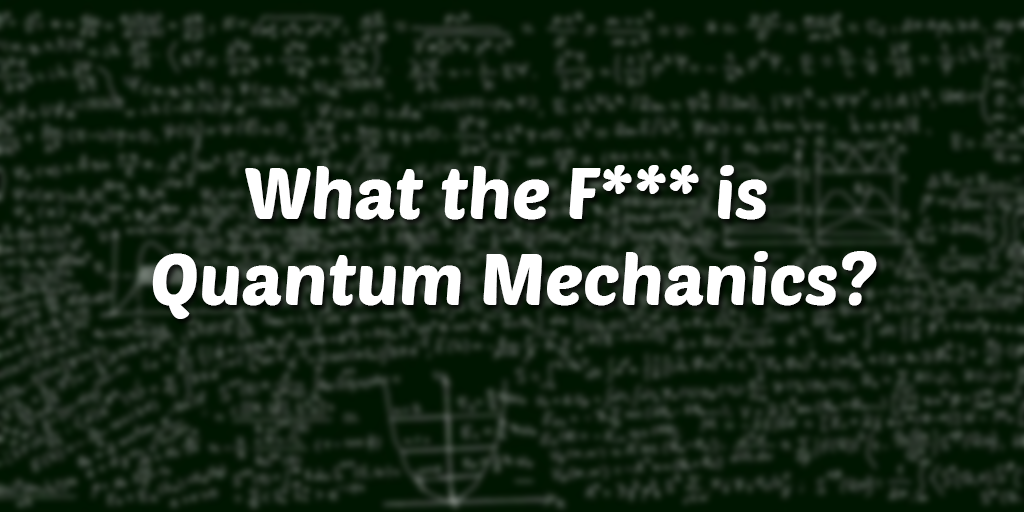
In this post I’m going to try and explain in the most basic terms (my) understanding of quantum mechanics.
I may not nail it completely for all standards, but hopefully you’ll leave the article with at least some more insight into what’s going on… and maybe a headache.
——-
Overview:
In school we learned that everything around us – the plants, animals, food, water, and air – were all made from atoms, ‘the basic unit of structure and function’.
There are around 109 different types atoms – called ‘chemical elements’, and we organize these on the ‘Periodic Table of Elements’.
The difference between all 109 of these atoms is the amount of protons in the nucleus – this is known as an elements atomic number.
1 proton is Hydrogen, 6 is Carbon, 26 is Iron, 79 is Gold, and 94 is Plutonium.
The nucleus of an atom isn’t a new thing – it’s just a word used to describe the bundle of protons and neutrons.
If you break down the proton/neutron bundle (nucleus) of an atom – both the protons and neutrons are made up of quarks.
There are 6 types of Quarks – Up, Down, Top, Bottom, Strange & Charm.
When quarks are grouped together they form ‘composite particles’, called Hadrons.
There are many unstable Hadrons, which only exist for picoseconds – but there are also stable hadrons which are called protons and neutrons.
A proton (a stable type of hadron) is composed of two UP quarks, and one Down quark.
So going up from quarks, we take 2 ups, and 1 down, and put those together to make a proton, and do the same for a neutron.
Now we have a nucleus (proton/neutron bundle) – and with only 1 proton, the element is called Hydrogen.
If you add an extra Proton to the Hydrogen atom, you get Lithium(2).
If you add an extra Neutron, you get a different type of ‘Hydrogen’ called Tritium which is less abundant (because it’s less stable).
If something is less stable, it means that it’s more likely to break apart through decay and find another state which is more stable, like the normal hydrogen.
This can be applied to quarks as well.
Up and Down quarks have the lowest mass, and are also the most stable of the quarks.
Top, Bottom, Charm and Strange are usually only found in high energy collisions, and otherwise turn into Up and Down quarks through particle decay (transition from a higher mass state to a lower mass state).
——-
Now we’re starting to see the structure of how everything builds up on the stable parts of the previous ‘iteration’ in order to create a new object of higher order.
Up and Down quarks are the most abundant because they’re the most stable.
Stable means they will exist longer, unstable means that, over time, they are more likely to decay, meaning we’re more likely to have less of them.
Up and Down quarks make up Hadrons, which can be both stable and unstable.
The stable ones work together, protons and neutrons, to make Atoms, which can be both stable and unstable.
The atoms that are stable, work together and make chemical compounds.
Some compounds are stable, while others are unstable. The unstable ones decay or explode.
The stable ones, stay around and join together with other stable compounds to create, again, both stable and unstable molecules.
This goes all the way up, and is pretty underlying process in most optimization systems — a sort of universal evolution.
————
Let’s get weird.
The first thing that’s important to understand – and gets confused through linguistics – is that quantum isn’t some thing thats just happening in a lab.
The lab is just where we measure this stuff.
The really interesting thing is that everything is quantum.
If everything is made of atoms, and atoms are made of quarks, and quarks are quantum, then my body is quantum.
This means my body SHOULD display the properties of quantum particles.
Now let’s think about the observer effect in quantum mechanics.
This is demonstrated through the double slit experiment, where photons act differently when being observed.
If you shoot a beam of light between two slits and observe the experiment, what you see is that the photons ‘choose a side’, and only choose 1 side.
When you shoot a beam of light between two slits and don’t observe the experiment, what you see is that the photons go through both sides.
This shouldn’t be possible, as there is only 1 photon, but because of it’s quantum properties, we see that the photon is actually existing in both places at once.
What’s happening is that unless there is some observer, the particle exists in all possible positions.
———-
So how is this possible?
How can the things that makes up my solid body – ultimately exist in two places at once.
And it’s not just 1 cell, it’s all my cells. So not two places, but trillions of potential places.
And not just my body, but everything.
Everything, ultimately, has multiple positions at the quantum level, but reality is showing us something much different.
We see single objects.
When you look at your friend – every quantum particle in all the atoms of all the cells in his body shift from existing in multiple states into a single state.
So how does the system remember which arrangement to use?
My face looks the same every time someone looks at me.
But if trillions of atoms exist in trillions of places at once, and find an equilibrium at a certain point when i’m being observed, how come it always finds the same arrangement?
How come my nose doesn’t end up looking different every time, or sometimes my nose is on my leg – it’s just one of those days.
With what we know about quantum mechanics, that would seem to fit much better. Things exist in multiple places, and they don’t always come together the same way so thats why sometimes you’ll wake up one day with 4 hands and sometimes 3 feet and no liver. Just the luck of the draw.
But that’s not how it is. There’s a timeline – the system seem to remember the previous state, and iterate upon it.
Maybe that’s what time is – it keeps the quantum state together on a thread – making sure to only use the previous iteration for future calculations.
If you were to go back and recalculate every iteration of everything, for each state in the system, that would be extremely inefficient – and we know the universe is pretty damn efficient.
So, isn’t that kinda of how a computer works?
Imagine world of warcraft – a game with a universe.
When your character is in Area X of the game, Area Z doesn’t really exist until you go there and your character needs to observe Area Z.
The game has to store the memory and code for Area Z , but it only loads it once it’s needed (being observed).
Until your character is observing Area Z, the data for it exists on your machine, but since it’s not being called by the application, Area Z would technically be ‘in all places at once’ – very similar to how quantum particles act when we’re not looking at them.
————-
This is really weird though.
I can look at my hand, which makes me the observer of the quantum particles in my hand.
How can a brain made of quantum particles, and eyes made of quantum particles, look at a hand of quantum particle, and make it shift from quantum to non quantum.
Jesus mindfuck.
– J



Edward
Feb 17, 2015 -
Lolz great article.. I love ur time thread concept.. I’m not smart enough to fathom the ending .. It doesn’t confuse me?
Ah .. Maybe u r trying to make t point that the observer effect must flip on and off?
Duck talking.
Lastly, I find it unreal the uncanny parallels with coding and quantum..
Your northern Irish following keep up the great brains.
keep up the great brains.
Regards
Julian Sarokin
Feb 17, 2015 -
Edward!
lol, not sure what point I was trying to make myself – lost it a bit in the end there haha.
– lost it a bit in the end there haha.
And yes, the parallels between coding / information theory and what we’re learning in quantum physics is insanely interesting… There’s gotta be some connection.
Thanks for reading & commenting!
Megha
Dec 17, 2016 -
I ws being polite all this time but never understood what ‘quantum level’ is. I put out a straight from the heart question on Google, and here I am. Haha
Thanks fr explaining so well. You made so many things clear.
Akshay
Aug 28, 2017 -
it was fun learning.. Enjoyed without being exausted